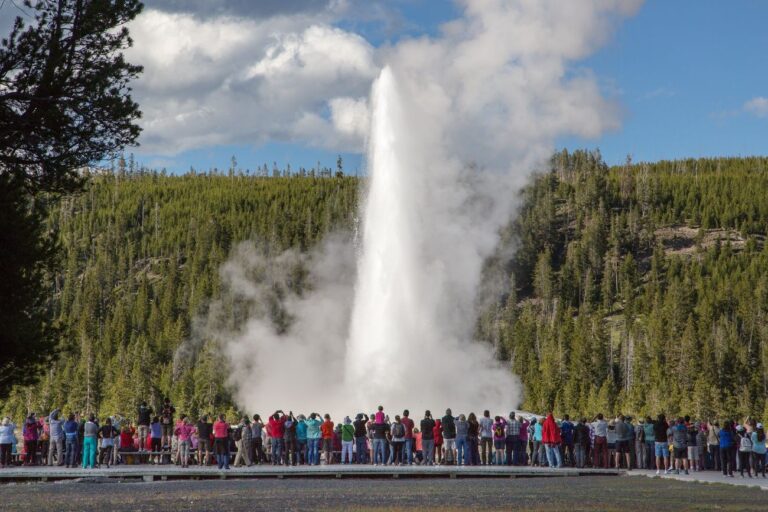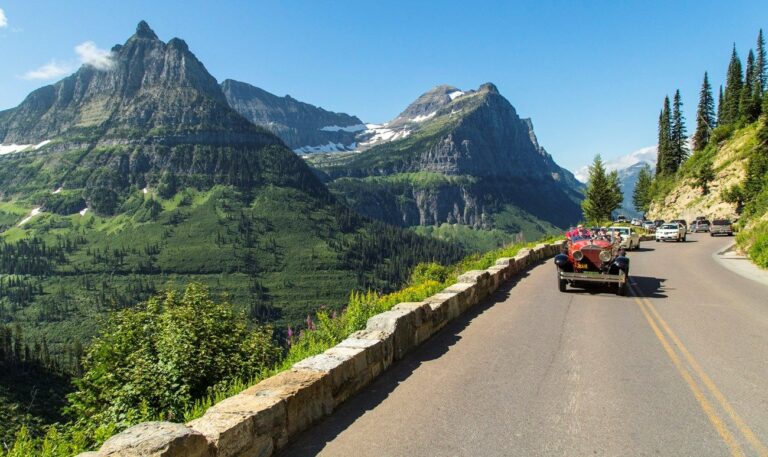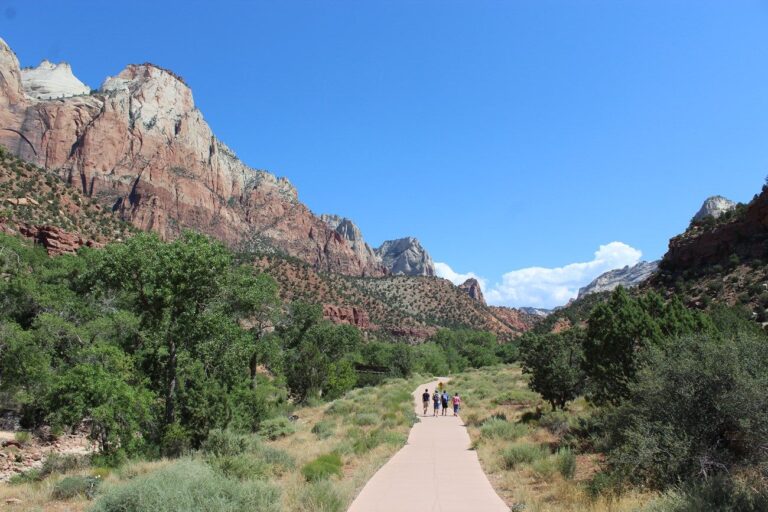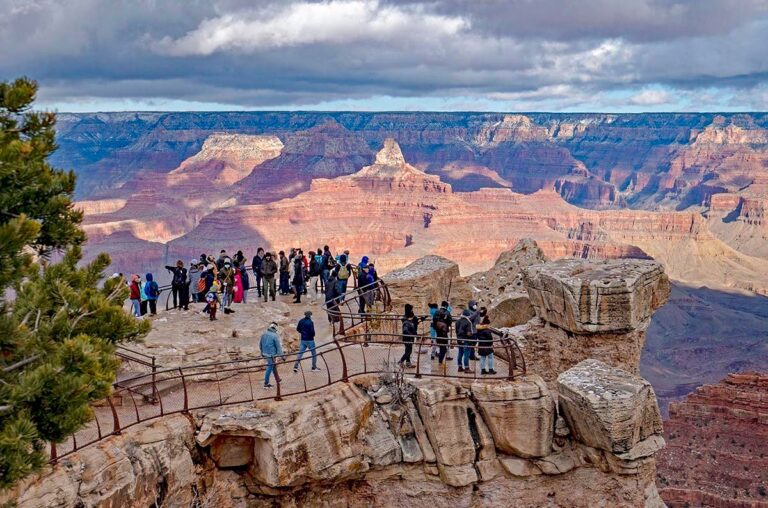What excites you more – gazing at the Grand Canyon’s vast expanse or watching Old Faithful’s majestic eruption? The United States boasts 63 national parks, and picking your first destination might seem daunting.
The breathtaking landscapes and scenic hiking trails have made these natural wonders famous worldwide. Each park brings its own flavor of outdoor adventure to the table. Thrill-seekers can scale Yosemite’s granite cliffs, while nature enthusiasts might spot grizzlies roaming Glacier’s backcountry.
Our carefully curated list features the 5 best national parks in the US, packed with insider tips and essential activities. This piece will guide you toward the perfect destination for your next memorable trip, regardless of your outdoor experience level.
Yellowstone National Park

Image Source: nps.gov
Yellowstone, the world’s first national park, shows evidence of nature’s most extraordinary wonders. This incredible wilderness spans over 3,400 square miles and features an amazing collection of geothermal features and wildlife that makes it one of the best national parks to visit in the US.
Yellowstone’s Best Adventure Activities
The park offers countless outdoor activities that showcase its breathtaking landscapes. You can head over to more than 900 miles of hiking trails during summer months, with options from easy walks to challenging backcountry adventures. The park’s public lakes, rivers, and streams provide excellent spots for fishing enthusiasts.
Looking for a unique viewpoint? A horseback riding expedition lets you experience America’s first national park authentically. Thrill-seekers can try whitewater rafting or test their limits at the Yellowstone Aerial Adventures zipline course.
Wildlife Viewing Opportunities in Yellowstone
The park has the largest concentration of mammals in the lower 48 states. Its diverse ecosystem supports an impressive variety of wildlife including:
- Grizzly bears and black bears
- Wolves and coyotes
- Bison and elk
- Moose and bighorn sheep
- Over 300 bird species
Lamar Valley, known as “America’s Serengeti,” offers the best wildlife viewing spots. Animals are most active during early morning and evening hours. Wildlife encounters peak in May and early June, while July and August visitors can watch the fascinating bison rut where bulls compete dramatically for mates.
Yellowstone’s Geothermal Wonders
The park’s remarkable geothermal features will amaze you. More than 10,000 thermal features dot the landscape, including the world’s greatest concentration of geysers, hot springs, mudpots, and steam vents.
The legendary Old Faithful geyser puts on a show every 90 minutes. It shoots between 3,700 to 8,400 gallons of boiling water up to heights of 106 to 180 feet. The Steamboat Geyser – the world’s tallest active geyser – creates an even more spectacular display by shooting steamy water between 300 and 400 feet high.
The Grand Prismatic Spring stands out as Yellowstone’s largest single hot spring and the world’s third-largest. You can best appreciate its deep blue center and orange spider-leg patterns from the nearby overlook trail, just a 0.6-mile hike away.
The park’s geothermal features come in five distinct types:
- Hot springs: Pools of hydrothermally heated water
- Geysers: Hot springs with constrictions causing periodic eruptions
- Mudpots: Acidic hot springs that dissolve surrounding rock
- Travertine terraces: Limestone formations from calcium carbonate deposits
- Fumaroles: Steam vents constantly releasing hot steam
Glacier National Park

Image Source: nps.gov
Glacier National Park sits majestically in Montana’s Rocky Mountains, with its rugged peaks, pristine alpine lakes, and abundant wildlife. This crown jewel of American wilderness stands out as one of the best national parks in the US, featuring breathtaking landscapes and outdoor adventures.
Glacier’s Most Scenic Hiking Trails
The park boasts 158 trails, and each reveals the park’s majestic scenery from a different point of view. The Highline Trail starts from Logan Pass Visitor Center and stretches 11.8 miles along the Continental Divide. The 8-mile round trip to Grinnell Glacier is a great way to get views of verdant meadows and turquoise-hued lakes.
Hidden Lake Overlook Trail packs stunning vistas and wildlife sightings into a 2.7-mile round trip from Logan Pass. Families love the Avalanche Lake Trail, a 4.5-mile round-trip that winds through old-growth forests.
Glacier’s Wildlife Encounters
The park teems with incredible wildlife – 71 species of mammals and 276 species of birds call this place home. One of the largest grizzly bear populations in the lower 48 states roams these grounds.
Tips for spotting wildlife:
- Head out during early morning or evening hours
- Keep your distance: 75 feet from most wildlife and 300 feet from bears
- Stay with your group and carry bear spray
- Let animals know you’re coming by making noise on trails
Many Glacier area stands out as a prime wildlife watching spot. Fishercap Lake draws moose regularly. Mountain goats frequent the rocky slopes near Logan Pass and the Highline Trail.
Glacier’s Going-to-the-Sun Road Experience
The Going-to-the-Sun Road might be the highlight of your visit. This 50-mile scenic drive crosses the Continental Divide and showcases engineering brilliance as it winds through the park’s heart.
Tips for the best drive:
- Beat the crowds by starting early – Logan Pass parking fills up by 9:30 AM
- Bring plenty of water and snacks – services are sparse between Lake McDonald and Rising Sun Motor Inn
- Dress in layers – Logan Pass runs about ten degrees cooler than lower areas
Don’t miss these stops:
- Heaven’s Peak
- Bird Woman Falls
- Jackson Glacier Overlook
- Wild Goose Island Overlook
Note that peak season (May 24 to September 8, 2024) requires both a park pass and vehicle reservation if you enter from the west between 6 AM and 3 PM. The park feels more relaxed in late September to early October, with fewer visitors and beautiful fall colors.
Zion National Park

Image Source: nps.gov
Zion National Park stands as one of America’s best national parks. Its magnificent sandstone cliffs rise in stunning shades of red and cream. The park draws more than 5 million visitors each year who come to explore its incredible canyons and outdoor adventures.
Zion’s Top Hiking Adventures
The park’s trails give you endless possibilities. You’ll find everything from gentle nature walks to challenging summit climbs across its 145,000 acres. Each trail shows you a different side of this amazing landscape.
Angels Landing will take your breath away. This tough 5.4-mile round-trip hike leads to spectacular views of Zion Canyon. You’ll need a permit to tackle this trail that comes with chain-assisted climbing sections.
The Emerald Pools Trail gives you a more relaxed option with three distinct parts:
- Lower Pools: 1.2-mile round trip
- Middle Pools: 2 miles round trip
- Upper Pools: 2 miles to reach the final destination
The park’s crown jewel, The Narrows, shouldn’t be missed. This famous hike takes you through the Virgin River’s slot canyon where walls stretch thousands of feet up. Walking through water makes this trail perfect for hot summer days.
Zion’s Canyoneering Experiences
The thrills reach new levels with Zion’s canyoneering spots. This area has more technical slot canyons than anywhere else in the world. These adventures can’t be found anywhere else.
Canyoneering mixes several activities:
- Rappelling down canyon walls
- Hiking through narrow passages
- Swimming through water-filled sections
- Technical rope work and problem-solving
The Subway and Pine Creek Canyon need permits, but many guided options exist nearby. Local experts can take you through routes that match your skill level, from beginner-friendly paths to technical descents with rappels up to 175 feet.
Zion’s Scenic Drives and Viewpoints
The park’s beauty unfolds on its scenic drives. The Zion-Mt. Carmel Highway runs through a historic 1.1-mile tunnel from 1930 and leads to amazing views including Checkerboard Mesa.
Kolob Terrace Road shows you Southern Utah’s beauty without the crowds. The sunset here turns mountains into glowing masterpieces. This road climbs to almost 9,000 feet at Kolob Reservoir, giving you a cool break from the desert heat.
The Kolob Canyons Road packs plenty of views into its five-mile stretch. This drive climbs 1,000 feet through red canyons. You’ll see narrow parallel box canyons cut into the Colorado Plateau with 2,000-foot walls.
Zion fits any schedule or adventure level. You can climb cliffs, wade through canyons, or cruise scenic roads. Each activity shows you why this park ranks among America’s finest.
Grand Canyon National Park

Image Source: nps.gov
The Grand Canyon stands as one of America’s most iconic natural wonders. You’ll find why it ranks among the best national parks in the US as you descend into its depths. This massive chasm, carved by the Colorado River, lets you experience its majesty in three ways – by foot, water, and air.
Grand Canyon’s Rim-to-Rim Adventures
The rim-to-rim adventure is your ultimate hiking challenge. This bucket-list experience spans 24 miles one-way. You’ll want to take the recommended route from North Kaibab Trail to Bright Angel Trail. The path takes you 6,000 feet down into the canyon before you climb 4,500 feet back out.
Your trek reveals eleven layers of ancient rocks that span two billion years of Earth’s history. The best hiking conditions exist between May and October. Phantom Ranch sits at the canyon bottom and gives you a welcome break with cold drinks and warm meals. Make sure you book well ahead of time.
This demanding trek matches the challenge of climbing Mt. Whitney, the highest peak in the Lower 48 states. You’ll need to prepare by focusing on:
- Cardiovascular endurance
- Knee and hip strength
- Heat adaptation
- Proper gear selection
Grand Canyon’s River Rafting Experiences
The mighty Colorado River reshapes the scene of your canyon adventure. Multi-day rafting trips run from 3 to 14 days and are a great way to get hidden views of the canyon’s treasures. Your trip can cover up to 225 miles of river with 73 rated rapids.
Fresh coffee aroma and rushing water echoing off canyon walls start each morning. Your expedition lets you find:
- Cascading waterfalls
- Secluded side canyons
- Lush oases
- Historical landmarks
Western River Expeditions runs both upper canyon (188 miles) and lower canyon (89 miles) adventures. The 3-day expedition from Whitmore Wash to Lake Mead works well for a shorter yet thrilling trip.
Grand Canyon’s Helicopter Tours
The natural wonder looks different from above. Helicopter tours fly from both the Grand Canyon and Las Vegas. You get maximum flight time to see the wilderness and scenic spots.
Your aerial options include:
- The Golden Eagle Air Tour shows you Hoover Dam and Lake Mead – perfect when time is tight
- Canyon floor landings take you 4,000 feet below the rim for champagne and snacks near the Colorado River
- Full adventure packages mix helicopter rides with ATV and jeep trips
The helicopters come with special sightseeing features like oversized windows and forward-facing seats. Tours take off multiple times daily, from early morning until late afternoon. Luxury packages include limousine pickup from Las Vegas Strip hotels.
Tour prices run from USD 350.00 to USD 600.00 per person. The cost changes based on tour type and extras like canyon floor landings or Skywalk visits. Travelers rate these tours as “once-in-a-lifetime” experiences and praise the amazing views and skilled pilots.
Yosemite National Park

Image Source: nps.gov
Towering granite cliffs greet visitors at Yosemite National Park, where nature shows off its most spectacular features. This crown jewel of America’s park system stands out as one of the best national parks in the US with amazing outdoor adventures.
Yosemite’s Rock Climbing Experiences
Climbing at Yosemite lets you follow the path of legends – the park has drawn climbers since the 1960s. The park’s clean granite routes have something for everyone, from gentle slabs to tough crack climbs.
New climbers can learn from certified wilderness first responders at the Yosemite Mountaineering School. Available options include:
- Welcome to the Rock: Introductory lessons for $205
- Crack Climbing: Intermediate techniques for $210
- Advanced courses: Multi-pitch climbing for $225
Swan Slabs near Camp 4 makes a perfect spot for beginners, while Tuolumne’s Puppy Dome offers cooler summer climbing. The legendary El Capitan awaits skilled climbers, with guided six-day climbs costing $7,000.
Yosemite’s Waterfall Hikes
Yosemite Falls stands as North America’s tallest waterfall with an incredible drop of 2,425 feet. The falls cascade in three distinct sections:
- Upper Yosemite Fall: 1,430 feet
- Middle Cascades: 675 feet
- Lower Yosemite Fall: 320 feet
The Lower Yosemite Falls trail offers an easy one-mile loop that works well for families and wheelchair users. More adventurous hikers can challenge themselves on the Upper Yosemite Falls trail, which climbs 2,700 feet over 3.5 miles.
The famous Mist Trail leads to stunning Vernal and Nevada Falls. Vernal Fall creates floating rainbows as it drops 317 feet, while Nevada Fall thunders down 594 feet. Hikers typically spend 2-5 hours completing the 7-mile loop.
Waterfalls reach their peak flow from April through June during snowmelt. Early morning hikes help avoid crowds. Good footwear and plenty of water are essential since wet granite can be dangerous.
Yosemite’s Giant Sequoia Groves
Ancient forests await at three distinct sequoia groves, with the Mariposa Grove standing as the largest and most visited. This remarkable grove protects about 500 mature giant sequoias, some older than 3,000 years.
Mariposa Grove’s star attractions include:
- The Grizzly Giant: A 2,700-year-old giant
- The Fallen Monarch: Known for its historic 1899 cavalry photo
- The Bachelor and Three Graces: Perfect for photos
Families can enjoy the Big Trees Loop Trail, an easy 0.3-mile wheelchair-friendly path featuring the Fallen Monarch. The Guardians Loop Trail offers a more challenging 6.5-mile trek through the upper grove past the historic Mariposa Grove Cabin.
The Tuolumne and Merced groves provide quieter alternatives. Both require moderate hiking with 500 feet of climbing. Hikers should carry water since these trails have no drinking sources.
Conclusion
These five national parks showcase America’s most spectacular natural wonders. Each park offers distinct adventures for every type of explorer. Yellowstone amazes visitors with its geothermal features and abundant wildlife. Glacier’s rugged peaks and pristine lakes create perfect hiking conditions. Zion’s towering sandstone cliffs beckon climbers and canyoneers. The Grand Canyon presents opportunities for epic rim-to-rim treks and river expeditions. Yosemite rounds out the collection with world-class rock climbing and magnificent waterfalls.
Your ideal national park experience depends on your interests and skill level. Beginners can start with shorter trails like Yellowstone’s Grand Prismatic Spring overlook or Glacier’s Hidden Lake trail. Experienced adventurers might prefer challenging routes such as Zion’s Angels Landing or Yosemite’s Upper Falls trail.
Planning ahead is essential since many popular activities need permits or advance reservations. You should think over visiting during shoulder seasons when crowds thin out and temperatures become more manageable. Pick your destination, pack your gear, and get ready for an unforgettable trip through America’s most stunning landscapes.




